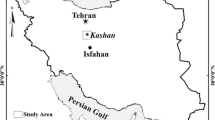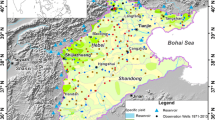Abstract
Hangzhou-Jiaxing-Huzhou Plain in northern Zhejiang Province, located between the Yangtze and Qiantang Rivers, is one of the regions where economic development is most rapid in China. Geological and hydrogeological surveys reveal a multi-layered aquifer system beneath the plain, which includes Holocene phreatic water layers and Pleistocene confined aquifers. Based on the historical records of groundwater extraction, groundwater levels, and ground settlement from 1964 to 2000, it is shown that ground subsidence has resulted from the continuously increasing extraction of groundwater from deep confined aquifers, and that the evolution of land subsidence can be characterized by a multifractal model. Based on this model, a set of empirical power-law relations have been established between: the land subsidence velocity and the annual groundwater extraction; groundwater drawdown and the annual land subsidence velocity; and the amount of land subsidence and the associated area of land. A set of indices are proposed for evaluating dynamic evolution of groundwater exploitation and land subsidence for the Hang-Jia-Hu Plain, from which the critical degree of evolution of land subsidence in the near future can be estimated using data on groundwater exploitation and water level changes.
Résumé
La plaine de Hangzhou-Jiaxing-Huzhou, située au Nord de la Province de Zhejiang, entre les rivières Yangtze et Qiantang, constitue l’une des régions de Chine où le développement économique est le plus rapide. Les reconnaissances géologiques et hydrogéologiques indiquent l’existence d’un système aquifère multicouche sous la Plaine, qui comprend les nappes phréatiques de l’Holocène et les aquifères captifs du Pléistocène. Les chroniques de prélèvements en eau souterraine, de niveaux piézométriques et de tassement des sols de 1964 à 2000 permettent de démontrer que les affaissements résultent de l’exploitation croissante des aquifères captifs profonds, et que leur évolution peut être caractérisée par un modèle multifractal. Un ensemble de fonctions puissance empiriques a été établi sur la base de ce modèle, entre la vitesse d'affaissement et les prélèvements en eau souterraine, entre les rabattements et la vitesse annuelle d’affaissement, et entre l’affaissement total et la surface concernée. Une série d’indices est proposée pour évaluer l’évolution des prélèvements en eau souterraine et des affaissements sur la Plaine de Hang-Jia-Hu. Ils permettent d’estimer le niveau critique d’évolution des affaissements à court terme, à partir des données de prélèvements en eau souterraine et de suivi des niveaux piézométriques.
Resumen
La Planicie Hangzhou–Jiaxing–Huzhou ubicada al norte de la Provincia Zhejiang y que se localiza entre los ríos Yangtze y Qiantang es una de las regiones donde el desarrollo económico es más rápido en China. Los levantamientos geológicos e hidrogeológicos muestran un sistema de acuíferos de varias capas que subyace la Planicie el cual incluye capas acuáticas freáticas Holocénicas y acuíferos confinados Pleistocénicos. En base a registros históricos de explotación de agua subterránea, niveles de agua subterránea, e información sobre colonización de 1964 a 2000 se muestra que la subsidencia del terreno ha sido ocasionada por la continua y ascendente extracción de agua subterránea en acuíferos confinados profundos, y que la evolución del hundimiento del terreno puede caracterizarse mediante un modelo multifractal. En base a este modelo se han establecido un conjunto de relaciones empíricas de potencia-ley entre: la velocidad de subsidencia del terreno y la extracción anual de agua subterránea; descenso de agua subterránea y velocidad anual de subsidencia del terreno; y la cantidad de hundimiento del terreno y el área asociada del terreno. Se ha propuesto un grupo de índices para evaluar la evolución dinámica de la explotación de aguas subterráneas y el hundimiento del terreno en el futuro cercano para la Planicie Hang–Jia–Hu. Los índices elaborados permiten estimar, usando datos de explotación de agua subterránea y cambios en niveles de agua, el grado crítico de evolución de subsidencia del terreno en el futuro cercano.












Similar content being viewed by others
Notes
In the Yellow Sea height system
References
Abidin HZ, Djaja R, Darmawan D, Hadi S, Akbar A, Rajiyowiryono H, Sudibyo Y, Meilano I, Kasuma MA, Kahar J, Subarya C (2001) Land subsidence of Jakarta (Indonesia) and its geodetic monitoring system. Nat Hazards 23(2–3):365–387
Barton CC, Scholz CH (1995) The fractal size and spatial distribution of hydrocarbon accumulation. In: Barton CC, La Pointe PR (eds) Fractals in petroleum geology and earth processes. Plenum, New York, pp 13–34
Bell FG, Cripps JC, Culshaw MG (1986) A review of the engineering behaviour of soils and rocks with respect to groundwater. In: Groundwater in engineering geology. Geol Soc Eng Geol Spec Publ 3:1–23
Bölviken B, Stokke PR, Feder J, Jössang T (1992) The fractal nature of geochemical landscapes. J Geochem Explor 43:91–109
Bunde A, Havlin S (1991) Fractals and disordered systems. Springer, Berlin Heidelberg New York
Chen CX, Pei SP, Jiao JJ (2003) Land subsidence caused by groundwater exploitation in Suzhou City, China. Hydrogeol J 11:275–287
Chilingar GV, Knight L (1960) Relationship between pressure and moisture content of kaolinite, illite, and montmorillonite clays. Bull Am Assoc Petrol Geol 44(1):101–106
Crovelli RA, Barton CC (1995) Fractals and the Pareto distribution applied to petroleum accumulation-size distributions. In: Barton CC, La Pointe PR (eds) Fractals in petroleum geology and earth processes. Plenum, New York, pp 59–72
De Waal JA, Smits RMM (1985) Prediction of reservoir compaction and surface subsidence: field application of new model. SPE 14214:1–11
Ferronato M, Gambolati G, Teatini P, Baù D (2003) Stochastic compressibility in land subsidence modeling, 16th ASCE Engineering Mechanics Conference, University of Washington, Seattle, 16–18 July 2003
Finol AS, Sancevic ZA (1995) Subsidence in Venezuela. In: Chilingarian GW, Donaldson EC, Yen TF (eds) Subsidence due to fluid withdrawal: developments in petroleum science. Elsevier, Amsterdam, pp 337–372
Geertsma J (1973) Land subsidence above compacting oil and gas reservoirs. J Petrol Technol 25:734–744
Gelt J (1992) Land subsidence, Earth fissures change Arizona’s landscape. Arroyo 6(2) http://ag.arizona.edu/AZWATER/arroyo/062land.html. Cited 05 April 2004
Geology and Mineral Resources: Zhejiang Province, Jiangsu Province, Shanghai City (1987) Report on the Evaluation of Hydrogeology and Engineering Geology in Yangtze Delta. Geology and Mineral Resources, Zhejiang Province, Hangzhou
Ghilardi P, Kai AK, Menduni G (1993) Self-similar heterogeneity in granular porous-media at the representative elementary volume scale. Water Resour Res 29:1205–1214
Jacob CE (1940) On the flow of water in an elastic artesian aquifer. Trans Am Geophys Union 21:574–586
Katz AJ, Thompson AH (1985) Fractal sandstone pores: implications for conductivity and pore formation. Phys Rev Lett 54:1325–1328
Krohn CE, Thompson AH (1986) Fractal sandstone pores: automated measurements using scanning-electron microscope images. Phys Rev Lett B33:6366–6374
Leake SA (2004) Land subsidence from ground-water pumping. http://geochange.er.usgs.gov/sw/changes/anthropogenic/subside/. Cited 06 Jan 2005
Lewis RW, Schrefler B (1978) Fully coupled consolidation model of subsidence of Venice. Water Resour Res 14(2):223–230
Li CJ, Ma TH, Zhu XS, Hu YH, Zhao NL (1999) Fractal, chaos and ANN in mineral exploration (in Chinese with English abstract). Geological Publishing House, Beijing
Li CJ, Zhao NL, Ma TH (2002) Fractal reconstruction with unorganized geochemical data. Math Geol 34(7):809–829
Li CJ, Ma TH, Shi JF (2003) Application of a fractal method relating concentrations and distances for separation of geochemical anomalies from background. J Geochem Explor 77:167–175
Li CJ, Ma TH, Chen JJ (2004) A fractal interpolatory approach to geochemical exploration data processing. Math Geol 36(5):593–606
Mandelbrot BB (1974) Intermittent turbulence in self-similar cascades: divergence of high moments and dimension of the carrier. J Fluid Mech 62:331–358
Mandelbrot BB (1983) The Fractal geometry of nature. Freeman, New York
Poland JF, Davis GH (1969) Land subsidence due to withdrawal of fluids. In: Varnes DJ, Kiersch G (eds) Reviews in engineering geology, vol 2. Geological Society of America, Boulder, CO, pp 187–269
Poland JF (1984) Mechanics of land subsidence due to fluid withdrawal. In: Poland JF (ed) Guidebook to studies of land subsidence due to ground-water withdrawal: studies and reports in Hydrology 40, prepared for the International Hydrological Programme, Working Group 8.4. United Nations Educational, Scientific, and Cultural Organization (UNESCO), Paris, pp 37–54
Pratt WE, Johnson DW (1926) Local subsidence of the Goose Creek oil field. J Geol 34:577–590
Rieu M, Sposito G (1991) Fractal fragmentation soil porosity, and soil water properties. 1. Theory. Soil Sci Am J 55(5):1231–1238
Schroeder M (1991) Fractals, chaos and power laws. Freeman, New York
Stanley HE, Meakin P (1988) Multifractal phenomena in physics and chemistry. Nature 335:405
Turcotte DL (1986) A fractal approach to the relationship between ore grade and tonnage. Econ Geol 81:1528–1532
Vega GF, Yamamoto S (1984) Techniques for prediction of subsidence. In: Poland JF (ed) Guidebook to studies of land subsidence due to ground-water withdrawal: studies and reports in Hydrology 40, prepared for the International Hydrological Programme, Working Group 8.4. United Nations Educational, Scientific, and Cultural Organization (UNESCO), Paris, pp 89–116
Wahyudi SI (2000) Evaluation and analysis of land subsidence in Tanjung Emas Harbour area in Semarang. Proceedings of the Sixth AEESEAP Triennial Conference Kuta, Bali, Indonesia, 23–25 August 2000, pp 509–514
Wheatcraft SW, Tyler SW (1988) An explanation of scale-dependent dispersivity in heterogeneous aquifers using concepts of fractal geometry. Water Resour Res 24(4):566–578
Zhejiang Geological and Environmental Monitoring Station (2000) Study report on groundwater resource exploitation and environmental impact in the Hang-Jia-Hu Plain, Zhejiang Province. Zhejiang Geological and Environmental Monitoring Station, Hangzhou
Zhejiang Province Dept. of Land and Resources (2002) Geological environment report of Zhejiang Province, Zhejiang Province Government, Hangzhou
Acknowledgments
We thank the Hydrogeology Journal reviewers for their valuable comments, which have improved the report significantly. We also particularly thank Dr. Zhiming Lu of Los Alamos National Laboratory for his thorough and careful correction of an early draft of the manuscript.
Author information
Authors and Affiliations
Corresponding author
Rights and permissions
About this article
Cite this article
Li, C., Tang, X. & Ma, T. Land subsidence caused by groundwater exploitation in the Hangzhou-Jiaxing-Huzhou Plain, China. Hydrogeol J 14, 1652–1665 (2006). https://doi.org/10.1007/s10040-006-0092-6
Received:
Accepted:
Published:
Issue Date:
DOI: https://doi.org/10.1007/s10040-006-0092-6




